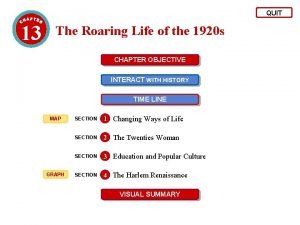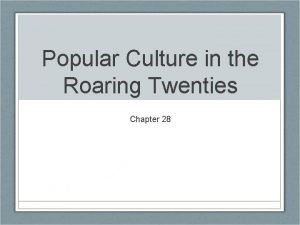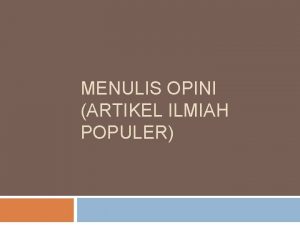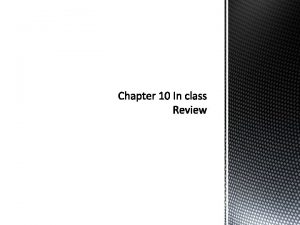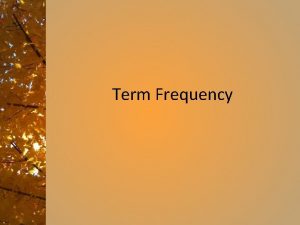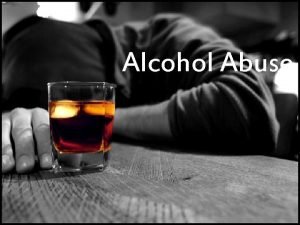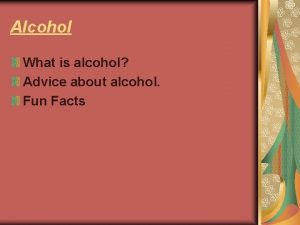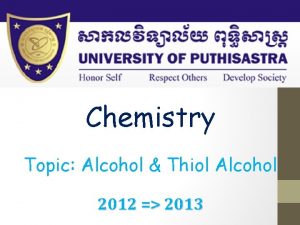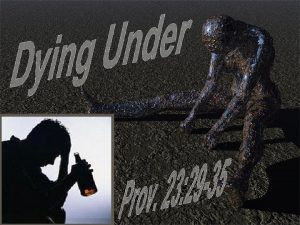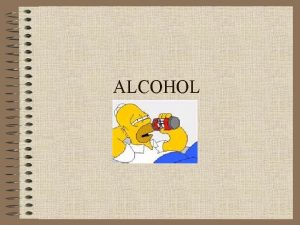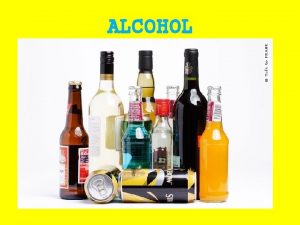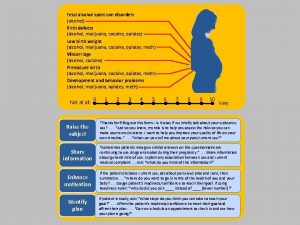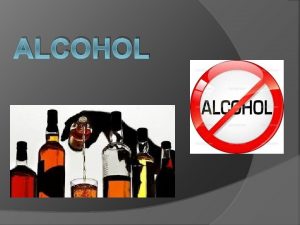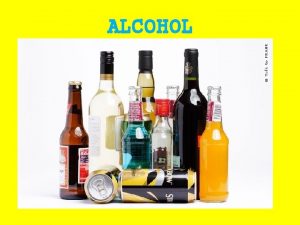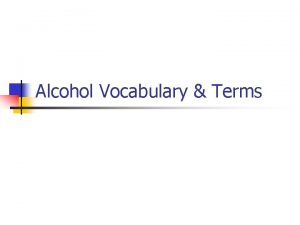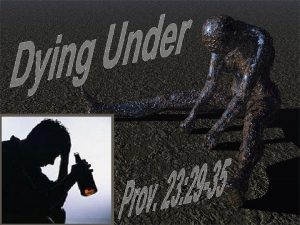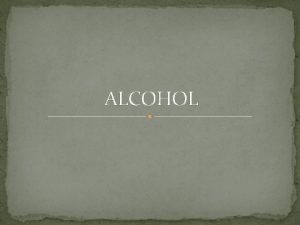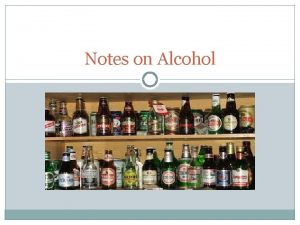ALCOHOL INTRODUCTION ALCOHOL THE TERM ALCOHOL IN POPULAR


![ALCOHOL THE TERM ALCOHOL IN POPULAR USE REFERS TO ETHYL ALCOHOL [ ETHANOL ] ALCOHOL THE TERM ALCOHOL IN POPULAR USE REFERS TO ETHYL ALCOHOL [ ETHANOL ]](https://slidetodoc.com/presentation_image_h2/5df6671e15c29700dea3ba52955e4763/image-3.jpg)






![METABOLISM [CONTD] � approximately � remaining 90% of the absorbed alcohol is oxidized in METABOLISM [CONTD] � approximately � remaining 90% of the absorbed alcohol is oxidized in](https://slidetodoc.com/presentation_image_h2/5df6671e15c29700dea3ba52955e4763/image-10.jpg)












![STAGE OF NARCOSIS [ contd ] If this stage lasts for more than 12 STAGE OF NARCOSIS [ contd ] If this stage lasts for more than 12](https://slidetodoc.com/presentation_image_h2/5df6671e15c29700dea3ba52955e4763/image-23.jpg)


























































- Slides: 81

ALCOHOL

INTRODUCTION
![ALCOHOL THE TERM ALCOHOL IN POPULAR USE REFERS TO ETHYL ALCOHOL ETHANOL ALCOHOL THE TERM ALCOHOL IN POPULAR USE REFERS TO ETHYL ALCOHOL [ ETHANOL ]](https://slidetodoc.com/presentation_image_h2/5df6671e15c29700dea3ba52955e4763/image-3.jpg)
ALCOHOL THE TERM ALCOHOL IN POPULAR USE REFERS TO ETHYL ALCOHOL [ ETHANOL ] WHICH IS PRESENT IN VARIOUS FERMENTED AND DISTILLED BEVERAGES. ALCOHOL IS TRANSPARENT, COLORLESS, VOLATILE LIQUID HAVING A SPIRIT LIKE ODOUR AND BURNING TASTE.

IT IS THE ACTIVE INGREDIENT OF MANY SOCIAL BEVERAGES SUCH AS WINE BEER WHISKEY BRANDY ITS APPROXIMATE %AGE IN SUCH BEVERAGES IS BEVERAGES ALCOHOL %AGE BY VOLUME DEGREES [ PROOF ] RUM 42. 8 75 WHISKEY / BRANDY 42. 8 75 GIN 42. 8/ 40. 0/ 37. 2 75/ 70/ 65 WINE 8 -15. 5 14 -27 BEER 2 -10. 0 3. 5 -17. 5 COUNTRY LIQUOR 11. 4 -45. 7 20 -80

PROOF SPIRIT THIS INDICATES A MIXTURE THAT CONTAINS 57. 10 % BY VOLUME OF ABSOLUTE ALCOHOL. OR 49. 28 % BY WEIGHT OF ABSOLUTE ALCOHOL.

ARRACK This is an eastern name for any country liquor. It is distilled from Coco-palm Rice Sugar Its strength may be as high as that of whisky. It is commonly fortified [to gain extra kick] with Potassium bromide Chloral hydrate Dhatura bhang

COUNTRY LIQUOR This although more intoxicating but will have the same clinical effects as ethyl alcohol. SERIOUS TOXIC EFFECTS ARE COMMON WHEN 1. 2. The liquor is adulterated by denatured spirit which contains methyl alcohol. The so called country liquor is prepared from toxic preparations like varnish and French polish containing methyl alcohol. INCIDENCE OF DEATH IS QUITE COMMON WITH THIS TYPE OF LIQUOR.

METABOLISM OF ETHYL ALCOHOL

METABOLISM OF ETHYL ALCOHOL � 1. 2. 3. 4. 5. 6. 7. ETHYL ALCOHOL IS RAPIDLY ABSORBED FROM GIT esp SMALL INTESTINES. The rate of absorption depends upon Concentration of the alcohol in the fluid imbibed. Presence / absence of food in the stomach. Condition of stomach wall [gastrectomy, chronic gastritis]. Rate of drinking. Quantity of alcohol ingested. Weight of the person. Development of the person.
![METABOLISM CONTD approximately remaining 90 of the absorbed alcohol is oxidized in METABOLISM [CONTD] � approximately � remaining 90% of the absorbed alcohol is oxidized in](https://slidetodoc.com/presentation_image_h2/5df6671e15c29700dea3ba52955e4763/image-10.jpg)
METABOLISM [CONTD] � approximately � remaining 90% of the absorbed alcohol is oxidized in the liver. 10% being excreted mainly by kidney and lungs. � NORMAL BODY METABOLISM OF ALCOHOL IN AN HOUR IS �½ � One fluid ounce of absolute alcohol. fluid ounce of whisky. [ one drink ] � 12 ounces of beer. IF THE INTAKE EXCEEDS THIS QUANTITY THE SUBJECT MANIFESTS SIGNS AND SYMPTOMS OF DRUNKENNESS UNLESS TOLERANCE HAS BEEN DEVELOPED.



ACUTE ETHYL ALCOHOL POISONING

� ethyl ETHYL ALCOHOL POISONING alcohol depresses the central nervous system irregularly in descending order from cortex to medulla. � It first depresses the higher centres which control judgment and behavior. [ stage of excitementblood alcohol 30 -100 mg% ] � Then it depresses the motor centres [ stage of incoordination -blood alcohol 100 -300 mg% ] � Finally the vital centres in the medulla are depressed [ stage of narcosis-blood alcohol over 300 mg% ] � The breath smells alcohol throughout.

STAGES OF ETHYL ALCOHOL POISONING STAGE OF EXCITEMENT. STAGE OF INCOORDINATION. STAGE OF NARCOSIS.

STAGE OF EXCITEMENT THIS IS A FEELING OF WELL BEING AND PLEASURE RESULTING FROM INHIBITION OF THE HIGHER CENTRES. THE PERSON � converses well. � Laughs and smiles readily. � Or may become angry easily. � May disclose secrets easily. � May behave in an obscene manner or talk in vulgar language. � Sexual desire may be aroused.

STAGE OF INCOORDINATION THERE IS INCOORDINATION OF � thought � speech � Action MANIFESTED BY � impaired judgment � confusion � slurred speech � staggering gait

STAGE OF INCOORDINATION THE DRUNK PERSON MAY � Suffer from hiccups � May be untidy in appearance

STAGE OF INCOORDINATION THE PERSON MAY DEPICT INHERENT EMOTIONS LIKE � Remorse � Euphoria � Irritability SIGN AND SYMPTOMS � Nausea � Vomiting � Dilated pupils

STAGE OF INCOORDINATION IMPAIRED JUDGMENT MAY LEAD TO MOST OFFENCES LIKE � Accidents � Sexual excesses � Violence � crime

STAGE OF NARCOSIS � The patient passes on to deep sleep and responds only to strong stimuli. � Pulse is rapid. � Temperature � Breathing subnormal. is stertorous.

STAGE OF NARCOSIS MCEWAN'S SIGN � Pupils may be contracted. � However on pinching the neck or face, they dilate initially and slowly return to their original size. � This sign is helpful to differentiate alcoholic coma from other comatose conditions.
![STAGE OF NARCOSIS contd If this stage lasts for more than 12 STAGE OF NARCOSIS [ contd ] If this stage lasts for more than 12](https://slidetodoc.com/presentation_image_h2/5df6671e15c29700dea3ba52955e4763/image-23.jpg)
STAGE OF NARCOSIS [ contd ] If this stage lasts for more than 12 hours Death may ensue from paralysis of Cardiac centre respiratory centre Or Later from effects of pulmonary edema.

ACUTE ALCOHOLISM � Death from acute alcoholism is not common. � Recovery occurs with acute depression and gastrointestinal irritation, which continues for 24 hours or longer.

Hang-over � Headache is also present as a hang-over effect, which is caused by cerebral edema. � hang-over means a temporary state of indisposition usually following recovery from drunkenness.

CLINICAL MANIFESTATIONS

BLOOD ALCOHOL LEVEL AND CLINICAL MANIFESTATIONS PERCENT MG % EFFECT LESS THAN 0. 03% LESS THAN 30 NOTICEABLE 0. 03 -0. 05 30 -50 SELECTIVE IMPAIRMENT 0. 05 -0. 10 50 -100 SLIGHT IMPAIRMENT 0. 10 -0. 15 100 -150 UNDER THE INFLUENCE 0. 15 -0. 20 150 -200 DRUNK 0. 20 -0. 30 200 -300 VERY DRUNK 0. 30 -0. 35 300 -350 STUPOR TO COMA OVER 0. 35 OVER 350 COMATOSE TO DEATH

CLINICAL MANIFESTATIONS � SELECTIVE IMPAIRMENT. � Increase in reaction time. � Impairment of complex skills. [ driving ] � Detectable only on detailed examination. � SLIGHT IMPAIRMENT. � Flushed face. � Dilated / sluggish pupils. � Euphoria. � Loss of restraint.

CLINICAL MANIFESTATIONS UNDER THE INFLUENCE. � Face flushed. � Dilated and sluggish pupils. � Euphoria. � Loss of restraint. � Test errors. � Stagger on sudden turning. � DRUNK � Face flushed. � Dilated/ sluggish/ inactive pupils. � Clouding of intellect. � Incoordination of thought, speech, and action. � Staggering gait with reeling and lurching while making sudden turns. �

CLINICAL MANIFESTATIONS � VERY DRUNK � Flushed or pale face. � Pupils inactive dilated [ may be contracted. ] � Mental confusion. � Marked incoordination of thought, speech, and action. � Staggering, reeling gait with tendency to lurch and fall. � Vomiting. � Amnesia. � SPECIAL NOTE. � These manifestations appear in persons who are not regular and excessive drinkers. � Recovery has been recorded after blood alcohol levels of 780 mg% and above.

FATAL DOSE FATAL PERIOD CAUSE OF DEATH

FATAL DOSE � THIS � Age. FATAL PERIOD DEPENDS ON THE � Habit of the person. � Strength of the liquor taken. � Death usually occurs from large dose taken in short period. � FATAL DOSE. � 0. 35 % [350 mg%] and above, concentration of blood alcohol is usually sufficient to cause death. � USUALLY IT IS � 12 -24 HOURS � ALTHOUGH DEATH MAY BE DELAYED FOR � 5 -6 DAYS

� DEATH CAUSE OF DEATH IS DUE TO DEPRESSION OF THE RESPIRATORY CENTRE. � ALCOHOL MAY BE LETHAL AT RELATIVELY LOWER BLOOD LEVELS WHEN Combined with other central nervous system depressants, such as Barbiturates Carbon monoxide Morphine Or in the presence of some natural heart or lung disease.

TREATMENT OF ETHANOL POISONING.

TREATMENT GASTRIC LAVAGE The stomach should be lavaged with care with 5 % solution of sodium bicarbonate in warm water. GENERAL MEASURES The patient should be kept warm. HYPOGLYCEMIA Isotonic solution with 5 % glucose [preferably fructose] may be required. INCREASED INTRACRANIAL PRESSURE. This often occurs and is to be treated with Saline purges and Intravenous hypertonic glucose solution

TREATMENT RESPIRATORY DEPRESSION Artificial respiration may be required along with oxygen inhalation. SERIOUS LIFE THREATENING EMERGENGENCY MAY NEED peritoneal dialysis Haemodialysis

POST –MORTEM APPEARANCE

POST MORTEM APPEARANCE CLOTHES. � Torn and disorderly. � Stained with blood and vomitus. � MISCELLANEOUS. � Tongue may be furred. � Rigor mortis lasts longer. � Bruises are found on various parts of the body. � Other injuries may be present. �

POST MORTEM APPEARANCE ON OPENING UP THE BODY. � Odour of alcoholic beverages is often evident. � Blood is fluid and dark. BRAIN � is slightly edematous. � Shrinkage of the cerebral cortex [grey mater] is common in chronic alcoholics. � In individuals who sustain head injury with subdural / epidural hemorrhage and survive for hours to days VITREOUS. � Vitreous analysis will reveal alcohol level in all the cases.

POST MORTEM APPEARANCE � GASTROINTESTINAL � Edema TRACT FINDINGS of the larynx. � Café coronary. [ bolus of food obstructing the larynx. ] � Fatty liver. � Acute hemorrhagic pancreatitis. � Stomach shows signs of alcoholic gastritis to a varying degree. � Mucus membrane of the small intestine is edematous but not ulcerated.

CHEMICAL EXAMINATION VISCERA SENT FOR THE CHEMICAL ANALYSIS ARE Stomach and its contents. Small intestine. Piece of liver, spleen, kidney. Vitreous fluid. Cerebrospinal fluid. Blood collected from a peripheral vein.

MEDICOLEGAL ASPECTS

MEDICOLEGAL ASPECTS POISONING BY ALCOHOL Although it is comparatively common but death directly due to its ingestion occurs in a far smaller number of cases. LIABILITY TO FATAL COMPLICATIONS MAY OCCUR SUCH AS Head injuries. Serious bleeding from trivial injuries. Café coronary leading to suffocation. Drowning. A STRONG RELATIONSHIP EXISTS BETWEEN ALCOHOL, CRIME, AND VIOLENCE.

CHRONIC ALCOHOLISM

ALCOHOL ADDICTION This results from the continued use of alcohol. IT IS CHARACTERISED BY GRADUAL DETERIORATION OF Physical health. Moral values. Mental intellect. Also known as ALCOHOLIC DEMENTIA.

PHYSICAL DETERIORATION THIS IS MANIFESTED BY Lack of personal hygiene. Loss of appetite. Chronic gastroenteritis. Wasting. Peripheral neuropathies. Impotence. Sterility. Fatty changes in liver and heart.

HEPATOTOXICITY OF ALCOHOL IS A HEPATOTOXIC POISON. Cirrhosis of liver is common. A useful index of liver damage is level of enzyme GAMMA -GLUTAMYL TRANSPEPTIDASE, in the serum, the normal level being less than 36 units.

MORAL DTERIORATION This manifests as crimes which the addict commits to get the drink. Mental degeneration results in dementia. The person may hit the family members and have an aggressive attitude.

COMMON CLINICAL SYNDROMES RESULT FROM CHRONIC ALCOHOLISM DELERIUM TREMENS KORSAKOFF’S PSYCHOSIS. ACUTE HALLUCINOSIS FETAL ALCOHOL SYNDROME.

DELERIUM TREMENS This is a state of excitement with hallucinosis which lasts 3 -4 days. THIS RESULTS FROM. � Unusual � Sudden � Acute bout of drinking. withdrawal of alcohol. infection, e. g. pneumonia or influenza. � Shock from injury e. g. fracture of bone. � Exposure to cold.

DELERIUM TREMENS THIS IS CHARACTERIZED BY Acute attack of insanity in which the main symptoms are � Sleeplessness. � Marked tremors. � Excitement. � Fear. � Visual and Auditory hallucinations. The person may seek escape from his terrifying new world by suicide. � The person is often violent with a homicidal tendency. person is considered insane for the time being and not held responsible for his actions.

KORSAKOFF'S SYNDROME � Korsakoff's syndrome � (also called Korsakoff's dementia, Korsakoff's psychosis, or amnesic-confabulatory syndrome) � This is a neurological disorder caused by a lack of thiamine (vitamin B 1) in the brain. � Its onset is linked to chronic alcohol abuse and/or severe malnutrition.

Signs and symptoms � There are six major symptoms of Korsakoff's syndrome: � anterograde amnesia � retrograde amnesia, severe memory loss � confabulation, that is, invented memories which are then taken as true due to gaps in memory sometimes associated with blackouts � meager content in conversation � Anosognosia (lack of insight) � apathy - the patients lose interest in things quickly and generally appear indifferent to change.

ALCOHOLIC HALLUCINOSIS �Alcoholic hallucinosis (or alcohol-related psychosis or alcohol-induced psychotic disorder) is a complication of alcohol withdrawal in alcoholics. �This develops about 12 to 24 hours after drinking stops and involves auditory and visual hallucinations, most commonly accusatory or threatening voices. �This condition is distinct from delirium tremens since it develops and resolves rapidly, involves a limited set of hallucinations and has no other physical symptoms. �The risk of developing alcoholic hallucinosis is increased by long-term heavy alcohol abuse and the use of other, illicit drugs

FETAL ALCOHOL SYNDROME �Birth defects in fetus of a pregnant alcoholic female which include �Mental retardation �Growth deficiencies �Malformations of skull and face

CONSUMPTION CASES • Common question raised at trials in consumption cases; 1) has the person consumed liquor? 2) if, so what is his blood alcohol level. ? • Medical officer should make a thorough clinical examination & follow All precautions during “collection of Blood samples” on the request of the Police.

CLINICAL EXAMINATION • In the absence of head injury & other pathological conditions, a person is definitely under the influence of alcohol. • if there is smell of alcoholic beverage in his breath and or in the vomited matter ( if any).

CLINICAL EXAMINATION 1) General demeanour: n n Excited Hilarious Talkative Abusive 2) Clothes: disarranged, disorderly 3) Eyes: pupils may vary from extreme dilatation to extreme contraction & may be equal or unequal. n Fine lateral Nystagmus is indicative of alcoholic intoxication. 4) Tongue: dry furred or excessive salivation 5) Speech: slurred & incoherent. 6) Memory: loss of confusion particularly as regards recent events & appreciation of time. Simple sum of addition or subtraction may be asked.

CLINICAL EXAMINATION 7) coordination: Ø Ø Ø Ø Ø impaired Unable to thread a needle Button his clothes Stand with his heels together with eyes closed Pick up coins dropped on the floor. Gait uncertain Stagger on sudden turning Tremors of the hand make writing difficult. Signature can be compared with that on the driving license. Finger nose test. 8) Reflexes: delayed & sluggish 9) Unusual actions : hiccups, belching, vomiting, fighting.

LABORATORY TESTS • • Blood Urine Vitreous fluid Breath

COLLECTION OF SAMPLES • Blood: n n n Skin is cleaned with soap & water not with spirit 5 mg OF SODIUM FLUORIDE & 15 mg OF POTASSIUM OXALATE CAN BE USED AS PRESEVATIVE FOR 5 ml OF BLOOD. Blood container should tightly be stoppered to prevent loss of alcohol by evaporation. It is kept in refrigerator Sent as soon as possible.

COLLECTION OF SAMPLES • Vitreous fluid: n n Can be taken in place of blood for post mortem alcohol estimation in drunken individuals from whom a blood sample is not obtainable due to excessive trauma. Only crystal clear colour less fluid should be used. It can be collected slowly with a syringe & 20 gauge needle. CSF, vitreous or bile can also be used when it is difficult to obtain blood due to decomposition.

COLLECTION OF SAMPLES • URINE: n n Urine sample is collected in a large, chemically clean, sterilized, screw capped bottle 30 mg OF PHENYL MERCURIC NITRATE IS USED AS A PRESERVATIVE FOR EVERY 10 ml OF URINE.

METHYL ALCOHOL WOOD ALCOHOL OR WOOD SPIRIT OR WOOD NAPHTHA OR CARBINOL OR METHANOL

METHYL ALCOHOL • • Colorless liquid Faint spirit like odor Burning nauseous taste Used in industry for denaturing rectified spirit so as to render it non-drinkable.

METHYL ALCOHOL • Rectified spirit mixed with 5% methyl alcohol is known as methylated spirit • used in arts & manufacture • It is found as an antifreeze in gas lines • as a solvent in paint removers, varnish, etc.

METHYL ALCOHOL • Methyl alcohol is more toxic than ethyl alcohol. • Peak blood concentration occurs in 30 -90 minutes. • It is distributed like ethanol, throughout the body in proportion to the water content of various tissues. • Volume of distribution is 0. 6 – 0. 7 L/kg

Methanol toxicity • excreted from the body by hepatic enzyme action, similar to ethanol. • It is oxidized to formaldehyde by alcohol dehydrogenase which is converted to formic acid by aldehyde dehydrogenase.


SIGN & SYMPTOMS • Symptoms may appear within an hour after ingestion but are commonly delayed. • Poisoning is manifested by ; n n n headache Dizziness Nausea Vomiting Pain in the abdomen Depressed cardiac action Spirit like odor usually present in the breath. Dyspnea & cyanosis Temporary blindness or in severe cases atrophy of the optic nerves resulting in permanent blindness Convulsions are common death results from respiratory failure Finding of intestinal contraction is diagnostic of methanol poisoning

MECHANISM OF TOXICITY THREE MAJOR TOXICOLOGIC CONCERNS ARE • Severe metabolic acidosis • Visual disturbances • Permanent blindness

MECHANISM OF TOXICITY ACIDOSIS • This results from rapid formation & accumulation of formic acid and lactic acid • This consequently results in increased anion gap ( difference between total cations and anions. )

MECHANISM OF TOXICITY OCCULAR DAMAGE • • • Blurred vision Decreased visual acuity Hyperemia of optic disc Retinal edema Fixed and dilated pupils with absence of light reflex Eventually blindness

FATAL DOSE • About 60 to 240 ml would kill most adults • As low as 4 ml is known to cause blindness.

FATAL PERIOD Death may occur within 24 -36 hours or may be delayed for 3 -4 days

TREATMENT • • Evacuation of stomach by emesis or lavage. • Correction of acidosis , achieved by sodium bicarbonate infusion immediately till urinary p. H is norma

• SPECIFIC ANTIDOTE • Ethanol has a greater affinity for alcohol dehydrogenase than methanol • Methanol does not get metabolized into toxic products and is excreted out • Ethanol is given orally or by intravenous injection as soon as possible. • Loading dose 0. 6 -0. 8 gm /kg followed by a maintenance dose of 125 -130 mg/kg/hr so as to maintain the blood ethanol level up to 100 mg/d. L.

TREATMENT • HEMODIALYSIS • This should be initiated if methanol concentration is greater than 25 mg/d. L. • It should be continued until blood methanol concentration is negative and acidosis is reversed.

MISCELLANEOUS • Leucovorin calcium is a folate analog which enhances the metabolism of formic acid to carbon dioxide via folate dependant enzyme systems. • 4 -Methylpyrazole is a potent inhibitor of alcohol dehydrogenase but is still in experimental stage.

POSTMORTEM APPEARANCE • • Cyanosis is marked Blood is generally fluid & dark Cerebral & pulmonary edema are seen G. I. T mucosa is inflamed Liver shows necrobiosis Kidneys shows tubular degeneration. Viscera's & postmortem blood should be preserved as outlined under ethyl alcohol.

MEDICOLEGAL SIGNIFICANCE • May be used accidentally • Intentional faulty sale • Intake of cheap local made alcohol
 What is secondary alcohol
What is secondary alcohol Mild oxidation of alcohols
Mild oxidation of alcohols Short, medium and long term planning in education
Short, medium and long term planning in education Term-to-term rule
Term-to-term rule Long term memory vs short term memory
Long term memory vs short term memory Nth term of a sequence
Nth term of a sequence Short term human resources examples
Short term human resources examples Position-to-term
Position-to-term Difference between long term and short term liabilities
Difference between long term and short term liabilities Accounting for serial bonds
Accounting for serial bonds Maxterm expansion
Maxterm expansion Rules in finding the nth term
Rules in finding the nth term Term to term rule
Term to term rule Long-term goals
Long-term goals Short term and long term cash forecasting
Short term and long term cash forecasting Hình ảnh bộ gõ cơ thể búng tay
Hình ảnh bộ gõ cơ thể búng tay Frameset trong html5
Frameset trong html5 Bổ thể
Bổ thể Tỉ lệ cơ thể trẻ em
Tỉ lệ cơ thể trẻ em Gấu đi như thế nào
Gấu đi như thế nào Chụp tư thế worms-breton
Chụp tư thế worms-breton Alleluia hat len nguoi oi
Alleluia hat len nguoi oi Môn thể thao bắt đầu bằng chữ đua
Môn thể thao bắt đầu bằng chữ đua Thế nào là hệ số cao nhất
Thế nào là hệ số cao nhất Các châu lục và đại dương trên thế giới
Các châu lục và đại dương trên thế giới Công thức tính thế năng
Công thức tính thế năng Trời xanh đây là của chúng ta thể thơ
Trời xanh đây là của chúng ta thể thơ Cách giải mật thư tọa độ
Cách giải mật thư tọa độ Phép trừ bù
Phép trừ bù Phản ứng thế ankan
Phản ứng thế ankan Các châu lục và đại dương trên thế giới
Các châu lục và đại dương trên thế giới Thể thơ truyền thống
Thể thơ truyền thống Quá trình desamine hóa có thể tạo ra
Quá trình desamine hóa có thể tạo ra Một số thể thơ truyền thống
Một số thể thơ truyền thống Bàn tay mà dây bẩn
Bàn tay mà dây bẩn Vẽ hình chiếu vuông góc của vật thể sau
Vẽ hình chiếu vuông góc của vật thể sau Biện pháp chống mỏi cơ
Biện pháp chống mỏi cơ đặc điểm cơ thể của người tối cổ
đặc điểm cơ thể của người tối cổ Thứ tự các dấu thăng giáng ở hóa biểu
Thứ tự các dấu thăng giáng ở hóa biểu Vẽ hình chiếu đứng bằng cạnh của vật thể
Vẽ hình chiếu đứng bằng cạnh của vật thể Vẽ hình chiếu vuông góc của vật thể sau
Vẽ hình chiếu vuông góc của vật thể sau Thẻ vin
Thẻ vin đại từ thay thế
đại từ thay thế điện thế nghỉ
điện thế nghỉ Tư thế ngồi viết
Tư thế ngồi viết Diễn thế sinh thái là
Diễn thế sinh thái là Các loại đột biến cấu trúc nhiễm sắc thể
Các loại đột biến cấu trúc nhiễm sắc thể Các số nguyên tố là gì
Các số nguyên tố là gì Tư thế ngồi viết
Tư thế ngồi viết Lời thề hippocrates
Lời thề hippocrates Thiếu nhi thế giới liên hoan
Thiếu nhi thế giới liên hoan ưu thế lai là gì
ưu thế lai là gì Sự nuôi và dạy con của hổ
Sự nuôi và dạy con của hổ Khi nào hổ mẹ dạy hổ con săn mồi
Khi nào hổ mẹ dạy hổ con săn mồi Hệ hô hấp
Hệ hô hấp Từ ngữ thể hiện lòng nhân hậu
Từ ngữ thể hiện lòng nhân hậu Thế nào là mạng điện lắp đặt kiểu nổi
Thế nào là mạng điện lắp đặt kiểu nổi Match the vocabulary word to the correct definition.
Match the vocabulary word to the correct definition. Essay structure
Essay structure Travelling is very popular nowadays
Travelling is very popular nowadays Popular piety bbc bitesize
Popular piety bbc bitesize Unalienable definiton
Unalienable definiton The beatles became the most popular
The beatles became the most popular Popular tartans
Popular tartans República popular da hungria
República popular da hungria It has 4 to 5 inches finely tapered blades
It has 4 to 5 inches finely tapered blades What is feature article
What is feature article Most popular religion
Most popular religion 1920 popular culture
1920 popular culture The principle of popular sovereignty means that
The principle of popular sovereignty means that Popular sovereignty examples
Popular sovereignty examples Costum popular osenesc
Costum popular osenesc Popular methodology
Popular methodology Chapter 28 popular culture in the roaring twenties
Chapter 28 popular culture in the roaring twenties Conto tradicional o que é
Conto tradicional o que é Um conto popular
Um conto popular Stuart hall deconstructing the popular
Stuart hall deconstructing the popular Tipos de conhecimento
Tipos de conhecimento Karya tulis opini adalah
Karya tulis opini adalah Mass media popular culture
Mass media popular culture Popular sovereignty poem
Popular sovereignty poem Is rap music more popular among young
Is rap music more popular among young




































































